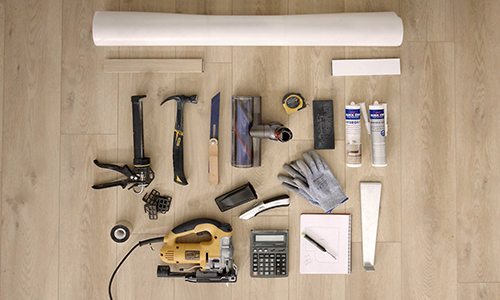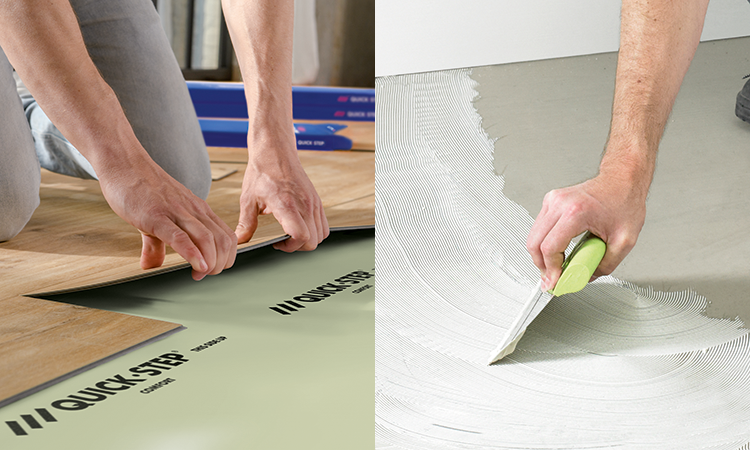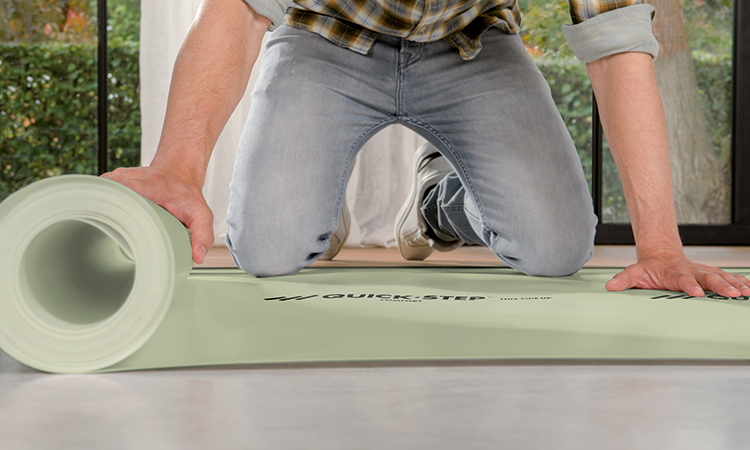
INSTALLING
YOUR HYBRID VINYL FLOOR
How to install your Hybrid vinyl floors
Quick-Step Hybrid vinyl floors are really easy to install. All it takes is a few tools and a little bit of patience and dedication.
STEP 1: Prepare your subfloor
First, you’ll need to inspect the subfloor. While Pulse Hybrid can handle most irregularities, we highly recommend making sure the surface is level, stable and clean, and to remove all existing floor covering before getting started.
STEP 2: Collect your tools
Save yourself a few trips and make sure you have the following tools handy:
- a hammer
- a saw that’s suitable for vinyl
- a mouth mask
- a tape measure
- safety glasses
- a bevel to measure the corners
- cleaning material
- a thin piece of rope
- gloves
- a pencil
- levelling compound
- calculator
- a Quick-Step installation set containing a pull-bar, spacers, and a tapping block

STEP 3: Start laying your Hybrid vinyl floor
- First, check how many full rows of planks you will need by dividing the width of the room by the width of a plank.
- Make a mark on the wall where you’ll be laying your last full plank. The last plank should be at least 5 cm wide to ensure easy installation.
- Unpack your planks and mix them up to avoid laying identical patterns and colour variations too close together.
- For best results, start laying your first row of Pulse Hybrid planks in line with the longest wall, but not flush against it (as walls are hardly ever perfectly straight).
- Make sure to alternate your alignment so that end joints of successive rows are never in line. We recommend at least 30 cm between them.
- Click the first plank of the second row into the first plank of the first row (see video) and keep going like that.
STEP 4: Cut your Hybrid vinyl floor
Inevitably, you’ll need to cut your Pulse Hybrid planks to complete your floor. Wear gloves and use a pencil to draw your cutting lines. Always saw your planks with the top surface decoration facing upwards.

Laying Vinyl Flex
STEP 1: Choose between click or glued-down installation
You just picked out the perfect floor, which can be installed in two ways: click (or ‘floating’) and glued down.
- Click/floating: the easiest and cleanest way to go, with all the stability you’ll need
- Glued down: ideal for large rooms, increased sound reduction, and high-temperature spaces

STEP 2: Prepare your subfloor
With Vinyl Flex, it’s important to ensure that your subfloor is perfectly level and devoid of any irregularities to avoid problems later on. Also make sure that cement joints wider than 1 mm are smoothed out, and don’t forget to check for mould or moisture.
How big can the joints in your existing tile floor be? How can you level out irregularities? What about underfloor heating?
STEP 3: Choose your underlay or glue
If you opt for a floating installation, choosing the right underlay is mandatory for a satisfactory result. We offer various underlays that were designed specifically for Quick-Step Vinyl floors.
My subfloor is perfectly level. Do I need an underlay?
Opting for a glued-down installation instead? Our Quick-Step Vinyl Glue+ is a high-quality adhesive especially developed for vinyl floors.

STEP 4: Collect your tools
Save yourself a few trips and make sure you have the following tools handy:
- Tape measure
- Safety glasses
- Thin rope
- Bevel to measure the corners
- Tape to secure your underlay
- Calculator
- Gloves
- Pencil
- Levelling compound
- Cleaning material
- Concave cutter knife
- Quick-Step Vinyl installation tool
STEP 5: Install your underlay (in case of floating installation)
It’s about to go down! Roll out your underlay (step 3) and push it as closely as possible against the wall. Lay one row at a time and make sure you go in the same direction as you plan to lay your floor (see step 6). Use adhesive tape to attach the rows together and prevent damage.
STEP 6: Start laying your Vinyl Flex floor
- First, check how many full rows of planks you will need by dividing the width of the room by the width of a plank.
- Make a mark on the wall where you’ll be laying your last full plank. The last plank should be at least 5 cm wide to ensure easy installation.
- Unpack your planks and mix them up to avoid laying identical patterns and colour variations too close together.
- For best results, start laying your first row of Vinyl Flex planks in line with the longest wall, but not flush against it (as walls are hardly ever perfectly straight).
- Make sure to alternate your alignment so that end joints of successive rows are never in line. We recommend at least 30 cm between them.
- Click the first plank of the second row into the first plank of the first row (see video) and keep going like that.
STEP 7: Cut your Vinyl Flex floor
Inevitably, you’ll need to cut your beautiful Vinyl Flex planks to complete your floor. Wear gloves and use a pencil to draw your cutting lines. Always cut your planks using the concave knife and the vinyl installation tool, and make sure the top surface decoration is facing upwards.
STEP 8: Finish your Vinyl Flex floor in style
Almost there! Now, it’s time to complete the picture with matching skirting boards and finishing profiles and other finer touches. Perfection is in the details!
Still got questions?
Need help finishing your project to your satisfaction?
Take a look at our help centre, which contains answers to the most frequently asked questions!






